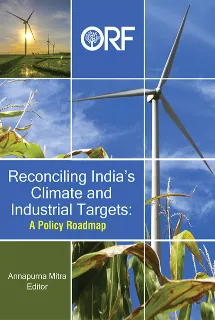Industry in India has never grown to the levels the government has desired – either in contribution to GDP or to employment. Numerous targets have been set, particularly for the manufacturing sector, following the growth models of China and other countries in East Asia. However, India has come up short, largely due to lack of infrastructure, arbitrary regulations in land, labour and tax systems, and a poor business climate. Since 2014, despite the government’s strong focus on manufacturing and ease of doing business, the sector remains at less than 15 percent of GDP, and unemployment is at its highest level in decades.
At the same time, India has performed remarkably well in terms of its climate trajectory over the past decade. As compared to 2005 levels, the country’s GHG emission intensity declined by 21 percent in 2014.1 According to Climate Transparency, India is the only country among the G20 nations that is on track to achieve the targets set under the Paris Agreement. One of the key, albeit unfortunate, reasons behind India’s climate success is the underperformance of its manufacturing sector. Since industries comprise approximately one-fourth of the economy’s total GHG emissions, sluggish growth in the industrial sector has led to moderate increase in industrial power demand and emission-intensity of GDP. The Indian government has set robust growth targets for its manufacturing sector. This includes the goal to ensure that manufacturing’s contribution to GDP is increased to 25 percent by 2025 from the current 16 percent. As growth in the manufacturing sector ramps up, it is likely to come into conflict with India’s climate ambitions. A comparison can be made of China: While manufacturing has powered the country’s economy over the last two decades, the sector also accounts for 68 percent of nation-wide energy consumption and 84 percent of CO2 emissions, as well as 24.1 percent of global emissions. The challenge for India is to achieve industrial growth on a low-carbon path.
With the COVID-19 pandemic and parallel climate crises and geopolitical shifts, however, there arises an opportunity to rethink India’s industrial sector and its place in the world economy. Globally, the COVID-19 crisis has brought into focus the fragility of vast, geographically spread out supply chains, which operate on ‘just in time’ principles. An additional fragility has been seen with China as the locus of too many supply chains. The tech industry, in particular, has started migrating rapidly out of China, with over 2,000 Japanese, Taiwanese and Korean companies announcing plans to diversify production. Their home governments have announced subsidies for the companies moving, with Japanese companies being incentivised to move to a number of countries, including India.
At the same time, the climate crisis has been used by a number of jurisdictions, most notably the countries in the EU, to accelerate their transition to a green economy. The UK announced a 10-point strategy for a ‘Green Industrial Revolution’ last year, aimed at simultaneously creating jobs and accelerating the shift to net-zero emissions. These domestic shifts will be accompanied by regulations and restrictions on trade, flows of finance, and increasingly sophisticated measurement of Environment Social and Governance (ESG) implementation along supply chains. Huge amounts of emissions arise not just from production, but transport costs along the supply chain. The typical multinational’s supply chain generates 5.5 times more emissions than its direct operations. The world might soon be shifting to shorter, more geographically localised supply chains.
For India, these two shifts provide a huge opportunity, provided the country is able to act quickly to benefit from them. India’s last industrial policy was published in 1991, in the throes of the license-quota-permit era, and was largely unsuccessful. A new one is due shortly, and this report attempts to make some recommendations for a policy regime that moves beyond the old model of government interference in business and markets, to one where the government actively works to address market failures, provide public goods and investment, and a regulatory architecture that supports green industrialisation.
The first section of this report examines three key elements of a shift to green industry: materials, technology and clean sources of energy. The shift from fossilfuel to renewable sources of energy will change India’s energy security calculus. While India has always been a net energy importer, it has managed to maintain a reasonably diversified supply chain so far. For renewable energy materials and machinery, however, supplies are geographically concentrated, which could lead to energy security concerns as the green transition progresses. The energy transition, therefore, will require an adequate supply of minerals, rapid technological innovation and the development of alternative sources of energy.
The pressing need to shift to clean energy and manufacturing has rapidly changed the types of inputs and raw materials required in industries. In Chapter 1, I examine the material needs of a shift to clean energy, which include a number of metals and minerals of which India lacks domestic endowments. Securing these supplies will require a number of measures. In the first instance, the government should conduct regular audits of the materials needed to meet clean energy targets. Global alliances and investments will be required to manage supplies of raw materials for which India lacks domestic endowments, as well as engagement with domestic industries to build up downstream supply chains. Finally, as the energy transition progresses, current infrastructure installations will rapidly start to become obsolete. Investment in technologies that enable recycling and reuse of the materials used could help in securing future supplies, as well as reduce the need for raw material extraction.
Secondly, a green transition for industry is necessarily a technological transition. In Chapter 2, Sangeet Jain highlights the importance of innovation-led growth in order to leverage the energy transition as an industrial opportunity. She identifies four major technological components for this transition, which include clean and widespread electrification, switching progressively to lower-carbon fuels and technology, resource efficiency, and finally, carbon capture and storage. She outlines specific policies that can support the development of these technologies.
Finally, ensuring a secure and reliable supply of clean energy to industries will now depend on creating a diversified supply chain for solar and wind energy infrastructure, as well as increased domestic manufacturing as described in Chapter 3. Nandini Sarma offers a series of policy recommendations that support the creation of a domestic clean energy industry. These include support to wind and solar manufacturing, creating and scaling up the use of hydrogen as a fuel, and finally, measures to incentivise technological development.
The next section looks at three sets of policies which can incentivise a shift to clean and sustainable modes of production. In chapter 4, Tanushree Chandra explores the viability of carbon pricing for Indian industry. She examines both government policies and private-sector initiatives for pricing carbon, in India and abroad, and suggests the need for a clear regulatory regime for pricing carbon. Remaining cognisant of both political economy challenges and the impact on industrial competitiveness, however, she suggests a policy pathway that looks to remove fossil-fuel subsidies in the short term. For the longer term, she suggests a carbon tax, with revenues redistributed back to households and firms, in order to mitigate the negative impact on consumption. This will require an immediate effort to strengthen India’s digital infrastructure and social protection systems, to facilitate this revenue recycling.
In Chapter 5, Ria Kasliwal looks at mechanisms to encourage a shift towards clean energy in industry, as well as low-carbon manufacturing in three high-emissions sectors: iron and steel, cement and automobiles. She focuses on market-creating strategies, to foster demand for green products. She suggests re-evaluating fiscal incentives, phasing out harmful subsidies, incentivising consumers through price subsidies, concessions or rebates, and use of public procurement to create demand. In addition, she highlights the importance of certification in changing consumption habits, as well as clear mandates and targets to support production.
In Chapter 6, Mihir Sharma focuses on the role of finance in encouraging a lowcarbon industrial sector. He provides an overview of current challenges in the Indian financial sector, focusing on the scarcity of investment finance and debt-related risks. His recommendations include using the priority sector lending framework to encourage the flow of finance to green industry, and the development of a comprehensive taxonomy for green finance. Complementary to these measures, he suggests enhanced disclosure rules coupled with stricter monitoring.
The last section assesses the potential for state government policies and corporate ambition to accelerate the green industrial transition. While India’s industrial policy was last updated in 1991, the states publish industrial policies every five years. In their overview of these policies, Manan Thakkar and Aakriti Rana, evaluate states on their policies relating to renewable energy, pollution control, the availability of state-level industrial parks, waste-water management, and incentives for water and energy efficiency. While they find that a number of states have incorporated green elements into their policies, the implementation and efficacy of these is unclear. They recommend a clear demarcation of budgetary support to these sectors, monitoring and evaluation mechanisms to assess policy effectiveness and impact studies to analyse whether these policies affect decisions undertaken by business and industries.
Akarsh Bhutani, in his chapter, studies the climate commitments made by privatesector companies. He finds that a number of large, publicly-listed companies have already made ambitious climate commitments, and have progressed towards setting science-based net-zero emissions targets. Companies in the ‘hard-to-abate’ automotives, construction and chemical sectors account for almost 40 percent of those setting net-zero targets. However, the MSME sector, which accounts for 37 percent of Indian GDP will struggle to catch up without support. He recommends that large companies be encouraged to account for scope-3 emissions along their value chains, thus creating an incentive for suppliers to improve sustainability outcomes. The government, on the other hand, can support SMEs by setting up green industrial clusters and parks, which provide the infrastructure needed to operate sustainably.
These eight chapters provide a policy roadmap that can help reconcile India’s attempt to generate economic growth and job creation through the manufacturing sector, and the country’s climate ambitions. These policy suggestions are suited to India’s economic, demographic and institutional conditions, as well as implementation capacity, that will support the creation of an internationally competitive industrial sector. The aim is to provide a blueprint that will address economic growth and job creation, while ensuring environmental sustainability, local production, and resilience to external shocks.
Read the full publication here.
The views expressed above belong to the author(s). ORF research and analyses now available on Telegram! Click here to access our curated content — blogs, longforms and interviews.

 PDF Download
PDF Download



 PREV
PREV


